Introduction on how to grow Tomatoes at home
Tomato belongs to the genus Lycopersicon under the Solanaceae family. It is a self-pollinated crop. Not only do you save money by growing Tomatoes at home, but you also get the reward of plucking perfectly ripe fruits from the vine. Tomatoes are the most popular vegetable grown in home gardens, but even small or no-space gardeners can enjoy a harvest of homegrown Tomatoes when they plant in containers. In this article we also discuss below topics;
- The signs of overwatering Tomato plants
- Why does my Tomato plant have flowers but no fruit
- How often should Tomatoes be watered
- What is the best fertilizer for Tomatoes
- How many Tomato plants grow in a bag
- Should I remove yellow leaves from a Tomato plant
- Why are my Tomato leaves curling up
- Do Tomatoes grow better in pots
- Can Tomato plants get too much sun
- Can you overwater Tomato plants
- How big of a container do you need to grow Tomatoes
- Can Tomato be grown in pots
A step by step guide on how to grow Tomatoes at home
Tomato plant growing conditions
Tomato plants thrive in 6 to 8 hours of daily sunshine. Containers can be moved throughout the growing season and are a good choice for home growers who have limited garden space. Be sure to provide enough room for each plant’s growth. To grow Tomatoes successfully, you want rich, fertile soil or peat-free potting compost, and a good sunny, sheltered spot.
Tomato seeds germinate readily in constant temperatures of 20 to 26°C, emerging in 6 to 14 days. Tomatoes will germinate in temperature level as low as 15°C, it takes longer. Starting seeds directly sowing them in the garden after the last frost date once soil temperatures reach 15°C or warmer will produce seedlings.
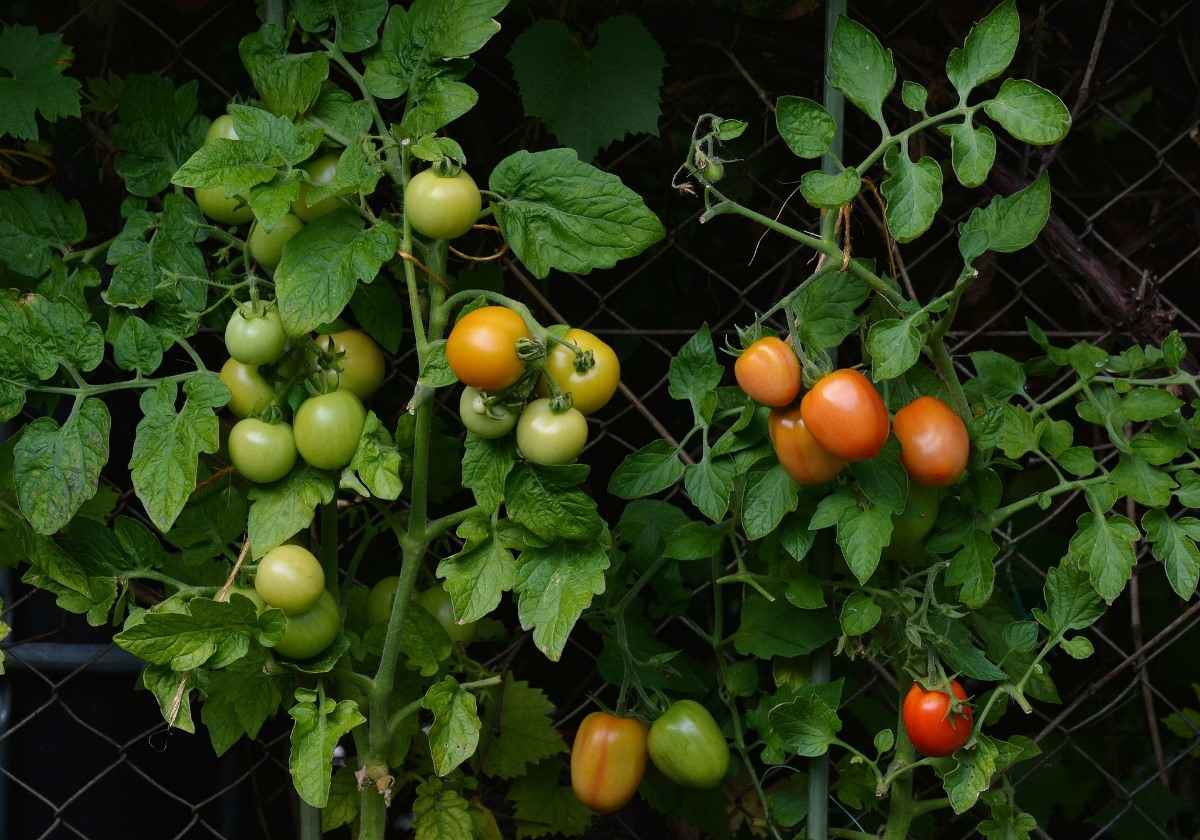
How to grow varieties of Tomatoes at home
- Determinate Tomatoes are plants that grow to a pre-determined height and they are good choices for canning and sauce-making.
- While indeterminate Tomatoes increase in height throughout the growing season. These Tomatoes are the choice if you want to spread out the harvest over a longer period.
Many organic gardeners include varieties of the following types of Tomatoes in their gardens each year.
- Cherry Tomatoes and salad Tomatoes produce small fruits in a rainbow of colours and an array of shapes, including round, pear-shaped, and teardrop-shaped.
- Slicing Tomatoes are round and juicy, making them ideal for eating fresh. Fruit size and colour change, and some varieties produce surprisingly large fruits.
- Paste Tomatoes are also called canning Tomatoes, have dense flesh and little juice, so they are the best type for cooking, canning, and drying.
How to grow Tomatoes in pots at home
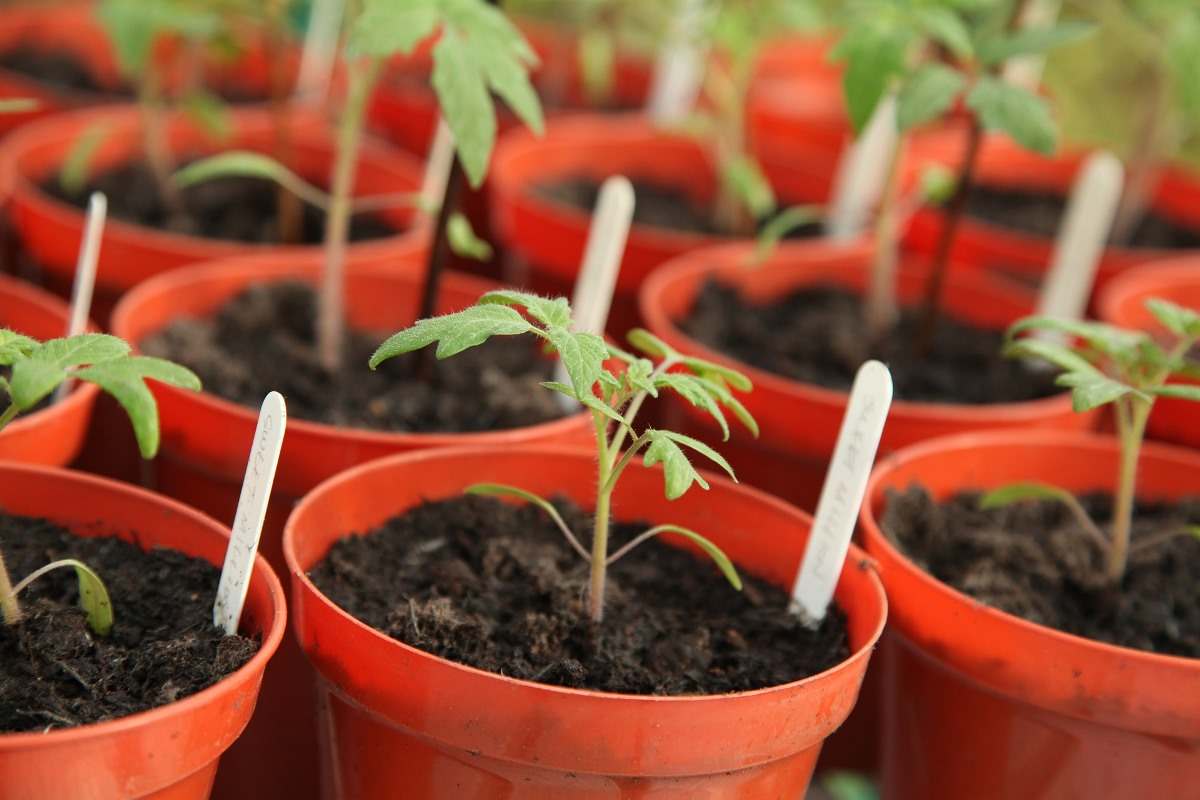
Step 1) Select the Right Containers and Soil – If you want to grow Tomatoes in pots, be careful to avoid clay or porcelain which can dry out quickly. Instead, select plastic or fibreglass. Select a larger pot that provides good drainage and plant your Tomatoes in peat or compost-based soil.
Step 2) When it comes to Tomatoes, the bigger the pot and the better. Determinate varieties must be planted in 10-gallon containers at a minimum, while indeterminate plant varieties need, at the very least, 20-gallon containers to thrive.
Step 3) Plant Tomato plants deeper than they come in the pot, all the way up to the top few leaves. When planted this way, Tomatoes can develop plant roots all along their stems. And more roots make for a stronger plant.
Step 4) Water deeply and regularly while the fruits are developing. Irregular watering that means missing a week and trying to make up for it leads to blossom end rot (a calcium deficiency) and cracking and splitting Tomato fruits. To ensure your plants get at least 1 inch of water per week, but during hot, dry spells, they may need more. If your Tomato plants start to look wilted for most of the day, give them a drink.
Step 5) After the fruit begins to ripen, you can ease up on the watering. Lessening the water will coax the plant into concentrating its sugars, for better flavor. Don’t withhold water so much that the plants continually wilt and become stressed or they will drop Tomato blossoms and possibly their fruit.
Step 6) Early signs of overwatering in Tomato plants include cracked fruit and blisters or bumps on the lower plant leaves. If the overwatering continues, the bumps or blisters on the plant leaves turn corky. Meanwhile, the plant roots begin to drown, die, and rot, which reduces the amount of water the green part of the plant receives.
How to grow Tomatoes organically at home
In case if you miss this: Backyard Hydroponic Gardening, Ideas, Setup, Tips.

- Normally, growing organic Tomatoes is simple even if you don’t have space for a vegetable garden. There are three keys to successfully growing Tomatoes organically. They are choosing the right Tomato variety, proper planting, and ongoing care.
- Tomato plants grow in almost all types of soil, except heavy clay. Loam and sandy loam soils are considered the best soil for growing Tomatoes. You can expect a very good crop yield if the soil gets full sun, well-drained, and is rich with organic materials.
- If the soil in your garden has lots of clay, then you can make it ready for growing Tomatoes by tilling the soil and incorporating sand, sawdust, and organic amendments before planting. Never use chemical fertilizer, and then try to use as many organic materials as you can (manure, compost, tree leaves, etc.). Adding compost, manure or other organic materials helps to improve clay soil.
- Organic insecticides like neem fertilizer are another option if you want to ward off the common pests and diseases of the Tomato plant. Also, frequent checks of the plant are another method to save the plant from some common problems. Moreover, organic seaweed fertilizers are a great way to promote more fruit in the Tomato plant. You can dilute the liquid seaweed concentration depending on your plant needs.
How to grow Tomatoes in grow bags at home
Step 1) Growing bags make the perfect, easy growing medium for greenhouse Tomatoes and outdoor Tomatoes. You can plant the Tomatoes directly into the growing bag, or you can try using a growing ring to increase the amount of compost the roots sit in. Plant Tomatoes about 45cm apart, leaving 75cm between rows, and if you’re planting into a grow bag, limit yourself to two plants per bag.
Step 2) Soak pots of young Tomato plants in a tray of water for an hour to fully hydrate them, which will help reduce plant root damage during transplanting.
Step 3) Then, cut a slot out of the bag to expose the compost for planting into. Use a hand fork to further dislodge compacted compost if necessary.
Step 4) If planting straight into the compost, use a hand trowel to make a planting hole, and gently knock the plant out of its original pot. Place the Tomato plant in the planting hole, replacing the compost and firming gently. Allow two plants for a 60-liter bag of compost, or three plants for a 75-liter bag and water in well.
Step 5) If using a growing ring and push this into the compost before planting the Tomato plant. And add more peat-free, multi-purpose compost to the center of the growing ring. Then plant as you would otherwise, taking care to water well and firm the compost around the Tomato plant.
Step 6) It’s a good idea to grow companion plants such as French marigold, Tagetes, to deter whitefly from Tomato plants. Then, place one plant into the planting hole next to the Tomato.
How to grow Tomatoes from seed at home
If you are starting Tomatoes from seed, and give the seedlings plenty of room to branch out. That means thinning the seedlings to one strong plant per cell or small pot.
To start, plant the Tomato seeds indoors in small pots about 3 to 4 inch deep or seed starting trays about ¼ inches deep in moderately fertile soil.
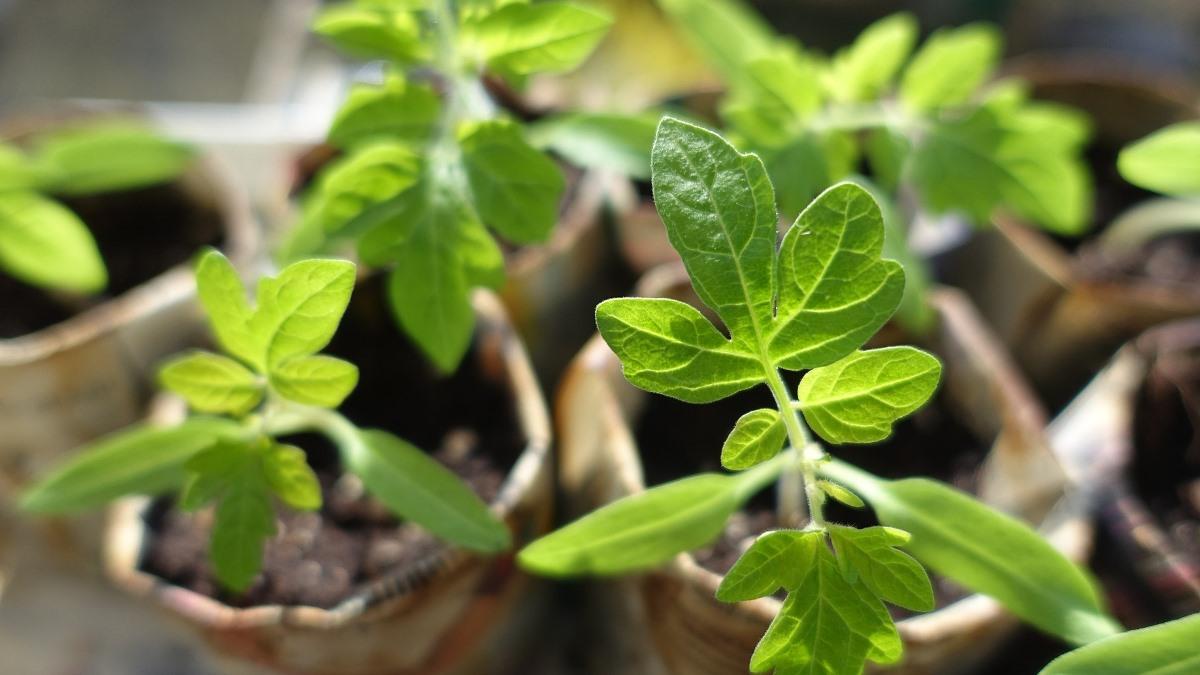
The temperature required for germination of Tomatoes seeds ranges between 21 to 27℃. For best seed germination results, keep the pots in a warm and dark place. The seedlings must appear in 10 to 14 days. Maintaining optimum soil moisture is essential for successful Tomato plant growth. Tomato seeds require very little watering till germination. Then, use a spray bottle to mist the seedlings to keep the top of the soil moist.
How to grow Tomatoes in the home backyard
You may also check this: Organic Square Foot Gardening.
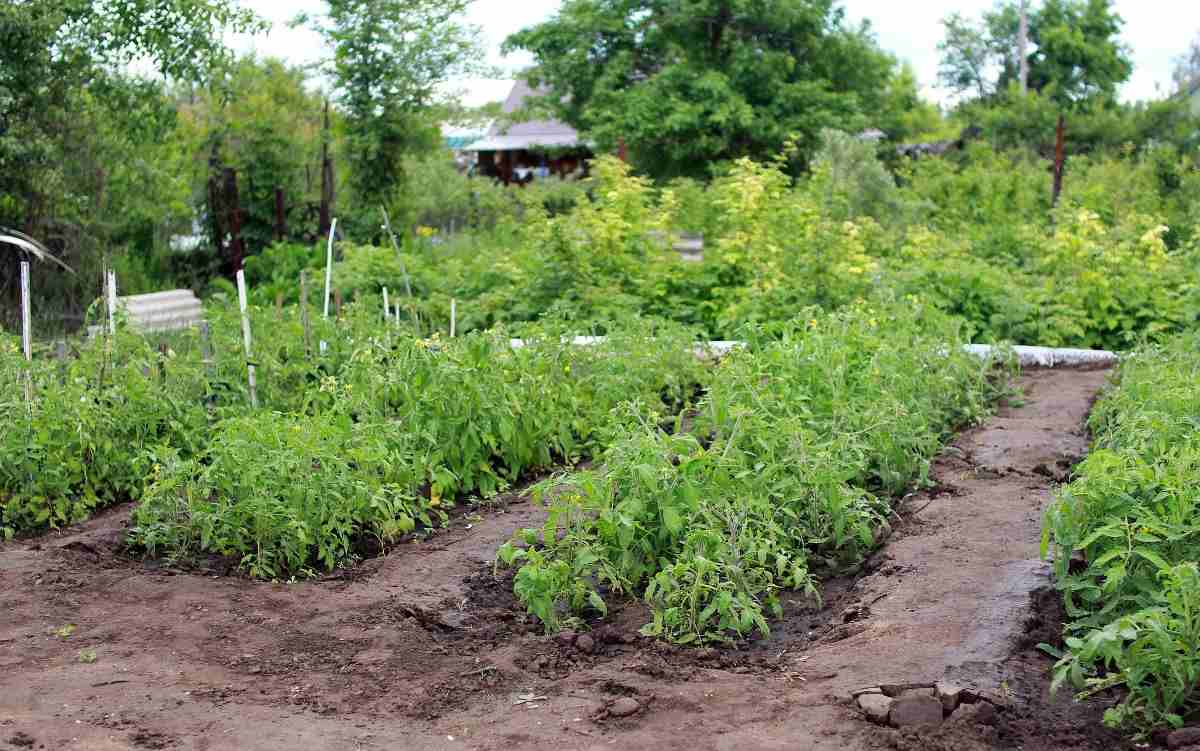
Step 1) Tomatoes are one of those crops that are easy to grow in almost any backyard garden. With these tips for growing Tomatoes, you too can have fresh, delicious Tomatoes right out of your backyard. When successfully Tomatoes are grown in the backyard, this plant bears Tomatoes over 3 to 4 months.
Step 2) Choose a growing location in the sunniest, hottest part of the yard. The best locations for growing Tomatoes are on the south or west sides of the home in direct full sun with exposure to the refection of light off the side of the house.
Step 3) Dig a hole 18 inches across and about 12 inches deep. Plant the Tomato plants about 2 feet apart and label each variety.
Step 4) Place Tomato cages over the top of the young plants. As the plants grow, lay the branches on the wires of the cage. The cage keeps the fruit off the ground and then supports the weight of the heavy branches.
Step 5) Feed Tomato plants with a fertilizer designed for Tomato plants or a mild plant food like fish fertilizer.
Step 6) Water the plants twice a week when the rain does not fall. Tomato plants require about 2 inches of water each week. Spread a thick layer of organic mulch such as straw around the Tomato plants 5 weeks after transplanting them.
How to Grow Tomatoes on the terrace of home garden
Tomatoes are one of those easily grown vegetables in a terrace garden that can be grown all-round the year. For growing Tomatoes, planters or pots are best for terrace gardens. Then, get a pot from the market or search your home to get any containers and recycle it. Cover the drainage hole at the bottom with stones so that there is space for the water to flow but no soil is discharged. Mix soil, compost, sand, and vermin-compost in equal quantities and fill the pot. Wet the soil and sow the seed or sapling and watch it bloom.
Tomatoes love to thrive well in sun. So always choose that sunny spot which gets a good amount of sunshine for about 8 to 10 hours. To grow Tomatoes in containers you need to start the seeds in a seed tray under controlled conditions as the seedlings take a good amount of time to grow. Then, fill up the seed tray loosely with a seed tray mix and give a tap so that it settles down nicely in the tray.
Always start with viable and healthy Tomato seeds. Fill the seedling tray with organic Potting Mix and sow the seeds. Sow one seed per cup and cover with a polythene sheet to ensure proper germination of seeds. The Tomatoes seedlings will be ready for transplanting to the pots/containers by 3- 4 weeks. Select large size containers as Tomato plants are huge feeders of nutrients with large root area. Also, ensure that the potting mix should be well-drained and rich in nutrients.
How to grow Tomatoes in the balcony of home or apartment
Growing Tomatoes on a balcony are rewarding. Besides their flavor and culinary uses, Tomatoes can also serve as an ornamental plant in the balcony. Almost any vegetable plant you can think of to grow in a backyard garden will also thrive in your balcony vegetable garden under the right conditions, including Tomatoes.
Tomatoes on the balcony must be planted in well-drained, stable pots. Keep in mind that a large amount of fruit and stems can cause the toppling of plastic or other lightweight pots in the wind. Although the container size depends on the plant variety, you’re growing. But it must be a minimum of 12 inches deep and wide in diameter. Tomato plant requires full sun so place them in the sunniest position of your balcony. While preparing the soil, remember it should have to be well-drained, permeable, slightly acidic pH level 6-6.8 and loamy, Tomatoes don’t thrive well in heavy soil. Also, mix slow-release Tomato fertilizer to the soil so that the plants will receive nutrition from time to time. The good news is that all the Tomato plant varieties are suitable for container gardening, but there are limitations like you can’t grow Tomato varieties that spread and become too tall (indeterminate ones) on your balcony (don’t blame us, if we believe balconies are small). The best idea is to select determinate varieties of Tomatoes that are locally available and grown successfully. For example, cherry Tomatoes, are easy to grow, low care and produce lots of fruits in a growing season.
The potting mix that you use for Tomatoes must be rich in minerals especially calcium. So be sure to add some fish meal or bone meal to your potting mix when you grow Tomatoes in containers. Additionally, you can add crushed eggshells to provide additional enrichment to the soil. Growing Tomatoes on the balcony constantly need moist soil as balconies remain windier than regular gardens. Regular watering of Tomato plants is essential, even twice on a dry, windy day in summer in a hot climate.
Tomato plant growth stages
The life cycle of a Tomato plant can be divided into three stages of growth.
The leaf stage – The leaf stage is when plants are developing their roots and top growth. Nitrogen is an important nutrient at this stage along with all the other elements in smaller amounts.
The flowering stage – It is exciting to see flowers open because each one is a potential Tomato. Though it is important to be aware of blossom drop and this happens when flowers fail to pollinate and the flower buds drop off the end of their stems. Whole trusses and clusters of flowers can fail which is disappointing. This is because flowers fail to set owing to very dry or very damp weather. Stress can cause plants to abort their flowers if they feel they cannot cope because of poor growing conditions or being over-watered or over-fed etc.
The fruiting stage – This is when flowers begin to set, that is, starting to show tiny pea-like Tomatoes as the blossoms fade and die away. It is at this stage that they need plenty of food like phosphorus and especially potash to be exact. It is also at this stage that if they don’t receive enough calcium, Blossom End Rot is waiting to strike. Because calcium is an immobile nutrient and doesn’t travel around a plant’s system freely, it is easier to spray the leaves with calcium, which helps get it to where it is needed quickly, than to hope for the best through the roots.
How to grow Tomatoes from cuttings at home
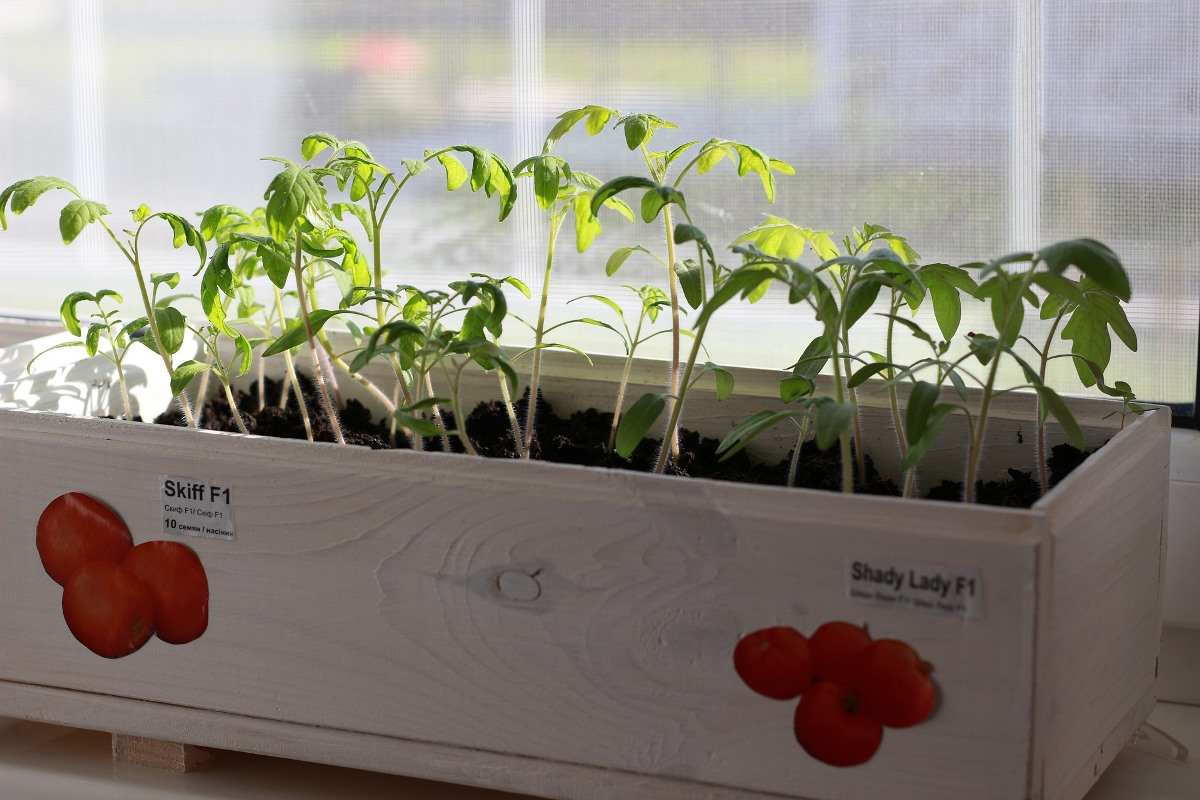
Tomato plants prefer full sun (at least 6 hours), although plants in extremely warm areas may benefit from some afternoon shade. The advantage of starting Tomato cuttings in this manner is that it can take seedlings, from seed, 6 to 8 weeks before they are of transplant size. Provided you keep Tomato cuttings warm, the transplanting time is reduced to just 10 to 14 days. It is a great way of overwintering Tomato cuttings.
Taking cuttings from existing plants in the garden is a great way of getting plants for free. You can increase the yield of Tomatoes by taking cuttings from your Tomato plants and growing them on. Then, they will produce fruit slightly later than the more developed plants that you took the cuttings from, but this may even help to extend the fruiting season into the autumn when grown in a greenhouse.
Tomato plant spacing

The spacing of Tomato plants is a very important component for healthy productive plants. The correct Tomato plant spacing is dependent upon which Tomato variety is being grown. Generally speaking, the ideal spacing for Tomato plants is between 24 to 36 inches apart. Spacing Tomato plants any closer than 24 inches will reduce air circulation around the plants and can result in disease.
Plant spacing depends on where you’re planting, whether in the ground, in a raised bed or containers.
In Containers – Except for the truly compact container Tomato plants, which can be grown in containers as small as 12 inches wide and deep, Tomato plants must be grown one per container in large containers at least 18 or 24 inches wide and deep.
In-Ground – If you’re planting directly in the ground, you could have more space and be planting in rows. In that case, space Tomatoes 18-24 inches apart along a row, but space your rows about 36 inches apart.
In Raised Beds – Guidance for planting in raised beds is similar to planting intensively in the ground. Space your Tomatoes in raised beds about 18-24 inches apart.
Tomato growing problems
Apply organic fertilizer every 2 weeks to Tomato plants growing in containers, and less often to plants growing directly in the ground. Crushed eggshells both fertilize the soil and deter soft-bellied pests from feasting on Tomatoes.
If your Tomato plants are grown with adequate space between them, the light will reach the lower leaves and they don’t have to be removed. When lower leaves start getting yellow it is a sign that they are shutting down and they must be removed before they become a sugar drain on the rest of the plant.
High winds, blowing dust and low humidity can damage the plant leaves and stems on Tomato plants. Heat and low moisture can cause the edges of the plant leaves to die back, then twist and curl. Hot dry weather may cause a symptom called physiological leaf roll.
Tomato fruit split uneven watering – A common problem with Tomatoes caused by irregular watering with some plant varieties more prone to this than others. A more regular watering regime must solve this problem.
Calcium Deficiency and Blossom End Rot – Blossom-end rot is a dark and often rotting area around the base of Tomato fruits and is mainly caused by a shortage of calcium. The problem can be under watering as calcium uptake is slowed in drought conditions. Again, a more regular watering regime must solve this problem.
Magnesium Deficiency – The symptoms are yellowing of the Tomato leaves while the leaf veins remain green, older leaves are affected first. The best remedy is by using ground magnesium limestone.
How much water do you need to grow Tomatoes?
Tomato plants need about an inch of rainwater or equivalent per week. If rains fail, watering plants at ground level is best and overhead sprinklers may spread fungal diseases. Lack of water, too much water or irregular watering could cause blossom end rot and crack.
Tomato pests and diseases, control methods
Few pests or diseases trouble outdoor Tomatoes, failure is caused by wet or cold weather. Leaves turning mottled, purple-veined or reddish under plant leaves are usually caused by nutrient deficiency caused by low temperatures. Roots are unable to absorb nutrients when the temperature is cold and this can also be the cause of blossom end rot.
Many fungal diseases spread up from the soil, so if you remove the bottom plant leaves, it slows the spread. Mulch helps to prevent disease spread from the soil.
The Tomato plant is susceptible to several garden pests such as Aphids, Cutworms, Flea Beetles, Whiteflies and Hornworms. The garden pests can be avoided by keeping a regular check on the Tomato plant and pinching off the affected foliage where there is a large concentration of the pests.
In addition to these, a few common diseases that can affect Tomato plant are Late/Early Blight, Blossom end rot, Leaf Roll
Blossom Drop – Tomato plant will flower but fall off without any fruit and this happens due to variations in temperature, lack of moisture or lack of pollination.
Fruit Cracks – Ripe Tomatoes will develop cracks due to humidity and insect bites.
When to harvest Tomatoes
Time of harvest for Tomatoes will occur at the end of its growing season, usually late summer, once the Tomatoes are at their mature green stage. Tomatoes harvested before this, such as those you buy at the supermarket, have been picked before this stage so they can ripen during transport and have a lesser flavour than those left on the vine a bit longer.
Tomatoes are best enjoyed right off the vine for their taste and flavours. After transplanting, you will start to see the Tomato fruit appear within 65 to 70 days. A fully ripe Tomato fruit will be softer than the unripe ones. Ripeness also varies with each variety of Tomato but most Tomatoes will be ready for harvest by late summer in planted in the early spring season.
In case if you are interested in this: Mulching Vegetable Crops.
Hi Jagdish Reddy
Growing Tomatoes on a balcony are worthwhile. Besides their taste and culinary uses, Tomatoes can also serve as an ornamental plant inside the balcony. Almost any vegetable plant you could consider developing in an outdoor garden may even thrive in your balcony vegetable garden beneath the proper conditions.